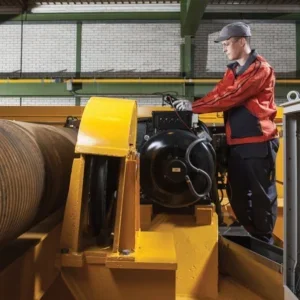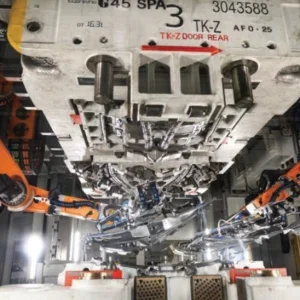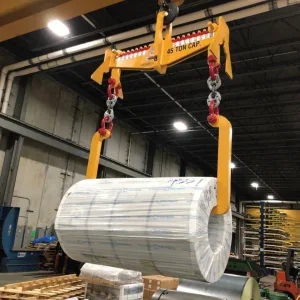To improve the running of the cable under the effect of wind forces, and consequently make it possible for such a cable to be used as a spreader cable, the core element formed as a supporting element comprises an assembly of braided lead cords on which a braid of tension-resistant plastic filaments is applied.

The core element of each bundle of wires comprises a braided lead cord, and braided lead cords are likewise arranged in the outer interstices of the core. The cords bring about an increase in the dead weight without noticeably increasing its flow resistance in the transverse direction or reducing its flexibility.
During the moving up and down of the hoist, the cable is constantly wound up onto and unwound from the drum or placed over a hopper and taken up again. The cable is in this case allowed to run freely through the air vertically over a considerable height.
In strong winds, this can lead to severe buckling of the cable, which can hinder the sequence of movements of the cable. To solve the problems described, it is proposed in the case of a drum-windable cable with stranding elements stranded in at least two stranding layers, in which the first stranding layer is arranged around a supporting element with a steel cable, that at least one stranding layer is provided with stranding elements that comprise a braided lead cord, an extruded polyamide- or polyester-based sheathing surrounding the lead cord and aramid-based rovings arranged between the lead cord and the sheathing in such a way that they run in longitudinally. The aramid-based rovings contribute both to maintaining the flexibility of the cable and maintaining the required tensile strength.
Object and summary
The present invention is based on the object of providing a cable of the type mentioned at the beginning with which it is possible to permit an in-situ measurement of the tensile forces acting on the cable and, on the basis of the measured values, control the winding speed with which the cable is wound up onto and unwound from a drum during operation.
Apart from the advantages arising directly from the object, there is also the advantage that higher winding speeds are achieved. In addition, an increase in the service lives of the cable and of the overall system is also achieved.
The illustration shows a drum-windable cable which has a central element (1), around which a first layer (2) of stranding elements (2A) is stranded. Wound around the first layer (2) is a further layer (3) of stranding elements (3A). The cable core comprising the central element (1) and the layers (2 and 3) is surrounded by a jacket (4).
Each stranding element (2A and 3A) has – as known per se – a not specifically designated, centrally arranged electrical conductor, for example, a fine-wired copper conductor, and a not specifically designated insulation, for example, based on ethylene-propylene rubber.
Between one layer (2) and the other (3) there is a separating layer (5) of a spun-bonded fabric made of polyethylene terephthalate. The length of lay of the individual stranding elements is approximately eight times the stranding diameter.
Arranged over the layer (3) there is a least one taping (6), likewise made of polyethylene terephthalate. It is preferred, however, for two tapings made of polyethylene terephthalate to be applied, with opposite directions of lay.
The taping (6) is sheathed by an inner jacket (7) made of an extruded rubber mixture, within the wall of which a braid (8) of polyester filaments is provided as a protection against torsion.
An extruded layer, which likewise consists of a material based on vulcanised or unvulcanised rubber, serves as the outer jacket (9).
The wire (1A or 1B) that is represented in Fig 2 comprises a core (10) made of a tension-resistant plastic. Aramid, which is available on the market under the trade name Kevlar, is preferred for this.
A multiplicity of copper wires (11) are stranded onto this core. The copper wires have with preference a diameter of 0.2 to 0.3 mm. There are between 20 and 60 of them. Over the layer of wires (11) there is a buffer tube (12), which consists of a compressible, elastically deformable material. With preference, the buffer tube (12) consists of an ethylene-propylene rubber.
Tensile forces
When the spreader is moved up and down, the cable is exposed to tensile forces of different magnitudes. One of the causes of these tensile forces is the dead weight of the cable that is wound up onto and unwound from a drum located above the spreader.
The constantly changing tensile forces acting on the cable have the effect of changing the distance between the conductors of the wires (1A and 1B). If current is flowing through the conductors, for example, they are connected to a voltage source, the capacitance of the pair of wires (1A and 1B) also changes. The changing of the capacitance is measured and is used as a controlled variable for controlling the winding speed of the winding drum.
About the patent
This patent was filed as number 11/786,048 on April 10 2007. The US patent, number 7,495,176, was awarded on February 24 2009.
Disclaimer
As edited versions of the originals, this article and accompanying drawings may omit legally or technically important detail. To see the full patent visit http://patft.uspto.gov/ and search for “hoist”. At the time of going to print the full patent was number 63 on that search listing.






